Lori Robinson's Blog, page 5
September 29, 2021
Animal Communication with a Chicken
“You want an animal communication session with your chicken?” I asked, not able to hide the myriad of thoughts racing through my mind.
In the several years since I started working as an animal communicator, and taking people on safari to connect with Africa’s wild beings, I’d never heard of, nor considered (shame on me), doing an animal communication with a chicken.
My mind was stuck on thoughts of failure, searching for any touch point, any information at all about communicating with chickens. Had any of my teachers or mentors ever mentioned sessions with a chicken? No.
“I love my chickens and would like to know if they are happy or if they need anything different from what I’m doing for them,” Stephanie said.
That makes sense. Why wouldn’t she want to know that? I thought to myself feeling very superficial about my initial reaction to Stephanie’s request.
The usual ask from a client concerns their dog, cat, and horse companions. I haven’t yet been asked to have a session with a hamster, parrot, or goldfish yet I wouldn’t hesitate to do animal communication sessions for those beings. So why was I discriminating against animal communication with chickens?
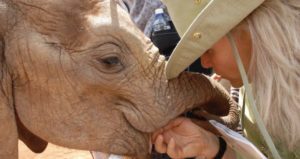
I know chickens, I reminded myself. I love chickens. Before I was officially an animal communicator, I had a flock of chickens pecking around my garden. My neighbor opened a portion of fence between our back yards to straddle a beautifully crafted coop between our properties. We shared the eggs, as well as the love, respect and care for our 6 girls.
“I’ve never had a session with a chicken but I’m willing to try,” I finally told Stephanie.
“The one I most want information about is Chaz,” she responded.
“I’m not making any promises.” I said, then added, “I’m not going to charge you,” hoping to relieve some of the pressure I was feeling.
Animal Communication with a ChickenAfter receiving the pre-requisite photos and answers to a few questions I had given Stephanie I meditated and began my session.
Some animals invite me into their space right away. Others take a while to warm up to our telepathic connection. Chaz was the former. I had hardly introduced myself before she began sharing all sorts of things. A few of her concerns were typical of what I would expect myself to already know about a chicken so I wasn’t sure if the information was coming from Chaz or me. But as the session progressed there was one particular topic that was unique enough to give me confidence that Chaz really was communicating with me.
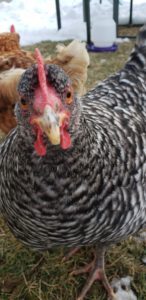
She was telling me something about water. Chaz showed me an empty bowl and I felt her thirst and dehydration.
By the end my session with Chaz I asked if there was anything she especially wanted me to tell her human companion. A vision of Chaz resting on a wooly red blanket folded in a square inside the chicken coop came into my mind’s eye.
This last bit of information erased all the confidence I had gained during our hour-long session. I was now sure my animal communication with this loving, friendly, talkative soul had been a complete bust. A blanket in a chicken coop? Highly unlikely, I rationalized. It would become filthy, the chicken’s claws would get caught in the weave, and it’s unnecessary, I told myself. I was a failure at chicken speak.
I can hear the words from the various teachers I’ve trained with over the years – “no matter how silly, wrong, and non-sensical you believe the information received during a session with an animal is, you should always share it. Let the human client validate it or not.”
So that’s what I did. I relayed to Stephanie the standard information I received and then I told her about the water.
Stephanie didn’t hesitate. “One of the other chickens has been knocking the water pale over and now I realize she is doing it before Chaz has a chance to drink.”
Encouraged by her reaction I added, “The last thing I got from Chaz is something I am not sure what to make of,” I said. “Sometimes an animal will share something with me that is out of context and I rely on the human to make sense of it.” The red blanket was such a moment.
“Chaz wants me to tell you that she loves the new red blanket you added to the chicken coop,” I said, then waited.
As if this were perfectly normal Stephanie said she was happy to hear that Chaz loves her new red blanket.
About a month later, after writing a wonderful post on Instagram about my session with Chaz, Stephanie contacted me.
“Can you please do a session for my Lemon Tree?” she asked.
“What?”
“Can you tell me what’s wrong with my Lemon Tree.”
I stared at the photos she sent me, willing my way into the energy field of the tree. But I couldn’t do it.
How much I still have to learn about interspecies communication, I thought, and left it at that.
The post Animal Communication with a Chicken appeared first on Saving Wild.
What I Learned From Talking to A Chicken
“With your chicken?” I asked, not able to hide the myriad of thoughts racing through my mind.
In the several years since I started working as an animal communicator, and taking people on safari to connect with Africa’s wild beings, I’d never heard of, nor considered (shame on me), doing an interspecies communication session with a chicken.
My mind was stuck on thoughts of failure, searching for any touch point, any information at all about communicating with chickens. Had any of my teachers or mentors ever mentioned sessions with a chicken? No.
“I love my chickens and would like to know if they are happy or if they need anything different from what I’m doing for them,” Stephanie said.
That makes sense. Why wouldn’t she want to know that? I thought to myself feeling very superficial about my initial reaction to Stephanie’s request.
The usual ask from a client concerns their dog, cat, and horse companions. I haven’t yet been asked to have a session with a hamster, parrot, or goldfish yet I wouldn’t hesitate to do animal communication sessions for those beings. So why was I discriminating against chickens?

I know chickens, I reminded myself. I love chickens. Before I was officially an animal communicator, I had a flock of chickens pecking around my garden. My neighbor opened a portion of fence between our back yards to straddle a beautifully crafted coop between our properties. We shared the eggs, as well as the love, respect and care for our 6 girls.
“I’ve never had a session with a chicken but I’m willing to try,” I finally told Stephanie.
“The one I most want information about is Chaz,” she responded.
“I’m not making any promises.” I said, then added, “I’m not going to charge you,” hoping to relieve some of the pressure I was feeling.
Talking To A ChickenAfter receiving the pre-requisite photos and answers to a few questions I had given Stephanie I meditated and began my session.
Some animals invite me into their space right away. Others take a while to warm up to our telepathic connection. Chaz was the former. I had hardly introduced myself before she began sharing all sorts of things. A few of her concerns were typical of what I would expect myself to already know about a chicken so I wasn’t sure if the information was coming from Chaz or me. But as the session progressed there was one particular topic that was unique enough to give me confidence that Chaz really was communicating with me.

She was telling me something about water. Chaz showed me an empty bowl and I felt her thirst and dehydration.
By the end my session with Chaz I asked if there was anything she especially wanted me to tell her human companion. A vision of Chaz resting on a wooly red blanket folded in a square inside the chicken coop came into my mind’s eye.
This last bit of information erased all the confidence I had gained during our hour-long session. I was now sure my animal communication with this loving, friendly, talkative soul had been a complete bust. A blanket in a chicken coop? Highly unlikely, I rationalized. It would become filthy, the chicken’s claws would get caught in the weave, and it’s unnecessary, I told myself. I was a failure at chicken speak.
I can hear the words from the various teachers I’ve trained with over the years – “no matter how silly, wrong, and non-sensical you believe the information received during a session with an animal is, you should always share it. Let the human client validate it or not.”
So that’s what I did. I relayed to Stephanie the standard information I received and then I told her about the water.
Stephanie didn’t hesitate. “One of the other chickens has been knocking the water pale over and now I realize she is doing it before Chaz has a chance to drink.”
Encouraged by her reaction I added, “The last thing I got from Chaz is something I am not sure what to make of,” I said. “Sometimes an animal will share something with me that is out of context and I rely on the human to make sense of it.” The red blanket was such a moment.
“Chaz wants me to tell you that she loves the new red blanket you added to the chicken coop,” I said, then waited.
As if this were perfectly normal Stephanie said she was happy to hear that Chaz loves her new red blanket.
About a month later, after writing a wonderful post on Instagram about my session with Chaz, Stephanie contacted me.
“Can you please do a session for my Lemon Tree?” she asked.
“What?”
“Can you tell me what’s wrong with my Lemon Tree.”
I stared at the photos she sent me, willing my way into the energy field of the tree. But I couldn’t do it.
How much I still have to learn about interspecies communication, I thought, and left it at that.
The post What I Learned From Talking to A Chicken appeared first on Saving Wild.
September 1, 2021
3 Reasons You Shouldn’t Wait to Go on an African Safari
If going on an African safari is on your dream list, then I say, don’t put it off any longer. Here’s why:
3 reasons you should not wait to go on safariReason #1 The cost of African safaris goes up every year.The costs from lodges, airlines, and operators in Africa rises each year as much as 10%. That means that a safari that costs $10,000 this year will be around $11,000 next year. For the same exact itinerary. Ouch.
Reason #2 There are less animals each year.
The numbers of animals like elephants, rhino, and lion are declining rapidly. My African safari itineraries focus on specific areas known for species like elephants, rhino, and big cats. This means the chance of seeing them is very high. That being said, the sad fact is that their numbers are declining.
Reason #3 There is no better time than now.
If this is a lifelong dream, you need to make it happen. You never know what the future brings, so why put it off any longer? The camps and lodges are less full (because less people are traveling), and the animals are less shy (because there are less vehicles and people on safari), so it’s a uniquely special time to go to Africa.
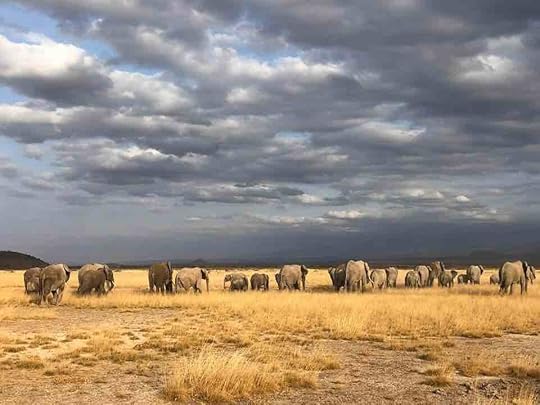 Among a sea of elephants in Kenya’s Amboseli Park.
Among a sea of elephants in Kenya’s Amboseli Park.There are other reasons you may have not yet signed up for an African safari yet.
-Covid has halted your travel.
-You can’t navigate the web’s overwhelming choices of where and when to go, and which operator to use.
-You don’t have anyone to travel with.
-You only have a dream about going on safari but don’t know where to start to make that dream a reality.
I’ve been leading safaris in Africa, and helping create custom safaris for people like yourself, since 2004.
I can answer all your concerns and questions and help focus your planning to create a life-changing safari. It’s my speciality.
So what are you waiting for – Contact me to start turning your dream into reality.
Email me: LoriSavingWild@gmail.com
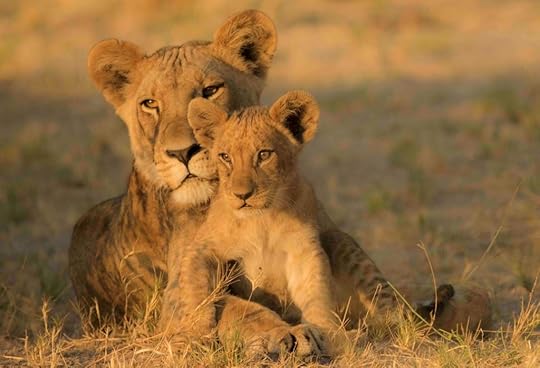 Up close encounters with wildlife is a trademark of all my safaris.
Up close encounters with wildlife is a trademark of all my safaris.
Now is the time to book your African safari. Send an email to me lorisavingwild@gmail.com so we can arrange a time to talk directly.
I look forward to talking to you soon.
Lv,L
The post 3 Reasons You Shouldn’t Wait to Go on an African Safari appeared first on Saving Wild.
March 24, 2021
A Wanna-Be’s Guide to Being Jane Goodall
Jane Goodall’s birthday is April 3rd. She will be 87. By that time in life, most people have chosen to retire, slow down and live a more quiet life. But being Jane Goodall, she has done the opposite.
She has turned up the volume on her work to save the world’s wild ones and wild places. Most years she travels over 300 days giving lectures, attending meetings like CITIES, accepting honors, and visiting and inspiring hoards of school children who are members of her worldwide Roots & Shoots program.
If there is news about wildlife, Dr. Jane is among the first to give a comment or make a widely quoted statement. Most recently she has been speaking out about the wildlife trade (as it relates to the spread of viruses).
In every way, she is a model for a life well lived, with purpose.
In celebration of my friend Dr. Jane’s birthday I’ve highlighted 14 characteristics I consider essential to being Jane Goodall.
I believe each of us can emulate some (or all) of these attributes to help us live our uniquely best purposeful life.
 Dr. Jane has been my role model since I was about six years old.
Dr. Jane has been my role model since I was about six years old.Find your passion and do not waiver from it. Since she was born (I am exaggerating but you get the gist) Jane Goodall knew she wanted to help animals. Imagine if you’ve spent 20, 40, 80 years focused on one thing. You would be an expert at it. And you would achieve a lot. Most of us get taken off our path because of impatience or because of family or cultural pressures. Find your passion and stick with it.
Be Yourself. There is no doubt in anyone’s mind what Jane Goodall stands for. She follows her own calling and passion. That makes her both unique and highly effective. So be yourself. Everyone else is taken.Be disciplined. Jane has a mission-like attitude. Indeed she is on a mission, and you feel it from all of her actions. She gets the job done no matter how tired, or overworked she is. And she doesn’t complain.Surround yourself with influential friends. And do things for them. Jane sometimes lends her name for events her friends are doing. She did a foreword for one of my books. She is generous with her time and heart. And people want to be around her and give back to her as well. Motivational teachers all tell us the same thing, “you are only as successful as the people you surround yourself with.” So surround yourself with people you want to emulate.Be determined. Did you know that Jane had to overcome her shyness in order to be a speaker? She had to overcome many obstacles to be able to do field work in Gombe Stream, and late in life she changed her career focus from a scientist to a conservationist to better help animals. Determination will get you far along your path in life.Adopt a minimalist mindset. Although I doubt Jane cares about the label of minimalist, she has always lived simply, even before this lifestyle was popular. Her staff told me she lives out of one small piece of luggage.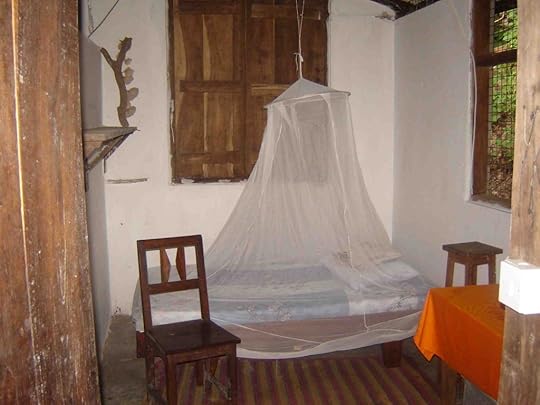 Dr. Jane’s bed at her house in Tanzania.MORE ON BEING JANE GOODALLWalk your talk. Knowing who you are, and what you are most passionate about, makes you believable to others. Because meat consumption is a huge contributor to climate change, and because of the abuse and suffering animals endure in factory farms, Jane is a vegan except when her grueling travel schedule only has vegetarian options. Take a stand for what you believe in and make sure you make all your lifestyle choices reflect your values and beliefs.Don’t give up. In the preface of my book,
Saving Wild, Inspiration From Fifty Leading Conservationists
, I tell a story. It’s about the time I asked Jane how she keeps going despite all the overwhelming bad news in the world. She fixed her green gold-specked eyes on mine and said, “I never give up.” At 85 Jane is probably doing more than ever to share her cause. The words, never give up, are simple. But they can be very difficult to put into action.Keep a sense of humor. Even though Dr. Jane works in a field that is challenging, and at times overwhelming and depressing, she seems to remain in good spirits.
Dr. Jane’s bed at her house in Tanzania.MORE ON BEING JANE GOODALLWalk your talk. Knowing who you are, and what you are most passionate about, makes you believable to others. Because meat consumption is a huge contributor to climate change, and because of the abuse and suffering animals endure in factory farms, Jane is a vegan except when her grueling travel schedule only has vegetarian options. Take a stand for what you believe in and make sure you make all your lifestyle choices reflect your values and beliefs.Don’t give up. In the preface of my book,
Saving Wild, Inspiration From Fifty Leading Conservationists
, I tell a story. It’s about the time I asked Jane how she keeps going despite all the overwhelming bad news in the world. She fixed her green gold-specked eyes on mine and said, “I never give up.” At 85 Jane is probably doing more than ever to share her cause. The words, never give up, are simple. But they can be very difficult to put into action.Keep a sense of humor. Even though Dr. Jane works in a field that is challenging, and at times overwhelming and depressing, she seems to remain in good spirits.
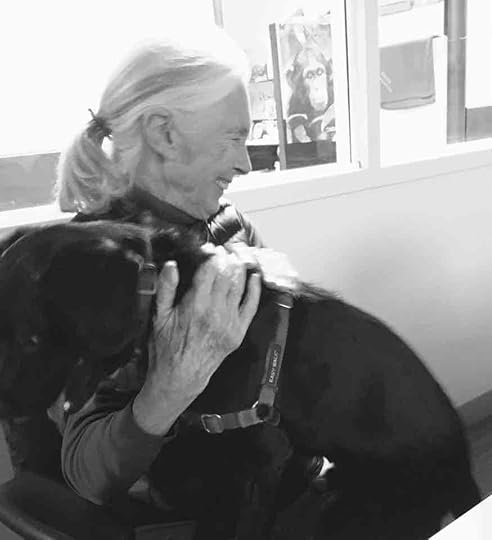
Remain Hopeful. Despite the fact that conservation is one of the most difficult fields to work in, she does not seem to give up hope. In fact, she is famous for her lectures and many books full of reasons for hope.Give people your full attention. If you have ever met and had a conversation with Jane you know she looks you straight in the eyes making you feel there is no one else in the room.Say Yes. Jane graciously gives her name to causes that are in line with the mission of her Jane Goodall Institute. That selflessness has only served to expand her name and message across the world.Learn to speak well. Jane is one of the best public speakers I have ever heard. Every one of her lectures has a signature beginning that initially grabs the audience’s attention. Watch her signature opening on my YouTube channel here. She then touches people by telling stories and evoking emotion. I have been in the audience many times when she was speaking and I always notice people crying and laughing. Be humble. Dr. Jane Goodall is perhaps the best-known name in the world related to conservation and animals, yet she remains unpretentious, simple and gracious.
We need inspiration now more than ever. And Dr. Jane continues to provide it through her work, and who she is in the world. By simply being Jane Goodall.
Send your wishes for Dr. Jane’s birthday in the comment section below.
For more on Jane Goodall check out my post, What you don’t know about Dr. Jane.
The post A Wanna-Be’s Guide to Being Jane Goodall appeared first on Saving Wild.
March 22, 2021
How to Increase the ‘Wild Factor’ in Your Garden
It’s raining catepillars. I’ve just come inside from working in my garden and find four of the pin-sized butterflies-in-the-making hitching a ride on my clothing.
I’m thrilled.
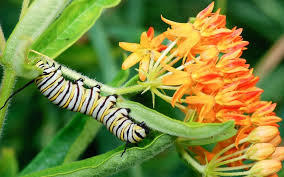
Why? Because although I’ve never been particularly drawn to caterpillars, I love birds. And as I recently learned, the majority of bird species rely on caterpillars (not seeds) for sustenance. Especially for feeding their babies.
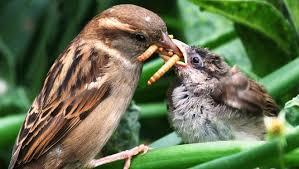 Birds rely on caterpillars, not seeds, to feed their offspring.
Birds rely on caterpillars, not seeds, to feed their offspring.
Bird parents need hundreds of the wriggling creatures a day to feed a nest full of growing fledglings. Having alot of caterpillars in the garden means I will be able to help sustain the breeding birds. I put out bird seed in Winter, but my feathered visitors need the catepillars for their main source of nutrition.
If you too are a bird lover you may be asking yourself how to get more catepillars in your garden?
I will tell you after I step outside for a moment to gently remove the wriggling creatures from my shirt and pants and place them on some leaf mulch.
OK, I’m back.
So, how do you support catepillars in order to support birds in your garden?
The good news is that there is one main thing you can do to help birds thrive –
grow a keystone native tree in your garden.
A one hundred year old oak embraces the back patio of my small California cottage. Its branches almost touch my bedroom sliding doors, comforting me when I sleep. Now that I’ve learned about the oak’s role as food and housing for over 400 species of catepillars my already immense respect and love for the resident tree has quadrupled.
Oaks (Quercus) are a keystone tree that will go a long way to helping your avian visitors and adding biodiversity to every garden. Keystone species for other areas include the cherry (Prunus), and willow (Salix). Those as well as birches, cottonwoods, and elms are the top woody producers in the USA.
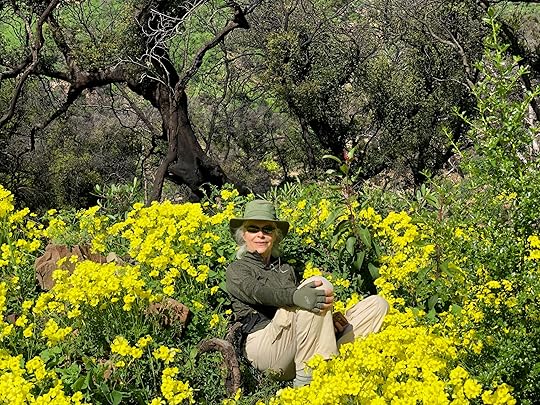 Find native plant inspiration for your garden along your local hiking trails.If you are thinking I don’t have room for a tree in my garden, read on.
Find native plant inspiration for your garden along your local hiking trails.If you are thinking I don’t have room for a tree in my garden, read on.If you don’t have room for a tree, plant herbaceous natives. Goldenrods, asters, and sunflowers (top three to plant in the US) also provide shelter and food needed for insects that feed birds.
When keystone species are removed from an ecosystem (your garden is an ecosystem) the arch of that system falls down. The food web falls apart. And the wildlife suffer.
Adding only one, or a few, of these native plant powerhouses will go a long way towards helping our wild friends, making your garden more eco- friendly and increasing biodiversity on this planet.
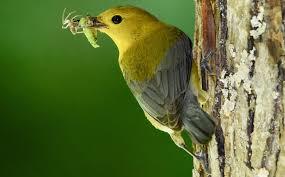 96% of bird species rely on insects for their nutritional needs.
96% of bird species rely on insects for their nutritional needs.
There is one more thing to consider in making the most of your plantings.
These keystone plants need to cared for in ways that enable the caterpillars to complete the four stages of their lifecycles. A catepillar’s egg and larval stages rely on the host plant. Afterwards, the grown caterpillar falls to ground under the tree (or bush) to burrow into soil or spin a cocoon in the leaf litter. This is just one of a myriad of reasons why not planting a lawn under your tree or bushes, and not raking up all your leaf litter are good gardening practices. Add ground cover, plant beds of compatible natives, or simply leave the leaves be. Your soil, tree, and wildlife will be better off.
To find out what keystone trees and herbaceous plants are good choices for your area visit the National Wildlife Federation’s Native Plant Finder website.
Saving Wild starts in any patch of earth (no matter how large or small) we have the privilege of stewarding. The wilder we allow (and encourage) our gardens to be, the better off our wild friends, the planet and we will be.
So go get yourself a new native caterpillar loving plant from your local nursery or botanical garden, and let me know what’s happening in your garden.
The post How to Increase the ‘Wild Factor’ in Your Garden appeared first on Saving Wild.
March 20, 2021
Five NGO’s Helping Animals that deserve your 2021 donation
You have enough to do then spend your time researching which organizations deserve your donations. So let me help you.
Here are my favorite five non-governmental organizations helping animals.
I have personally vetted each of these, giving them a ‘thumbs up’ for their effectiveness, ethics, and ability to use your money wisely. They are all unique and probably ones you have not heard of.
If you want to help animals, you can’t go wrong donating to any, or all, of these wonderful organizations.
On the other hand, maybe you want to avoid sending out five separate donations, and being solicited from them in the future?
Then simply donate to SavingWild here:
 [Note: Donations are processed through our non-profit umbrella, The Key Biscayne Foundation, and are fully tax-deductible.]
[Note: Donations are processed through our non-profit umbrella, The Key Biscayne Foundation, and are fully tax-deductible.] Your money will be bundled with other donors and distributed among these five organizations helping animals. And we never send out solicitations!
Here are my Favorite five NGO’s Helping Animals
I recently had the privilege of visiting this new sanctuary in Northern Kenya’s Samburu region. So many of the orphaned elephants in Kenya come from this area so it makes my heart sing to know that these traumatized babies can now be taken care of on the land they are familiar with, near elephant families they recognize, rather than flown or trucked hours away to be cared for in Nairobi.
Created by the Wildlife Conservation Network in partnership with the Leonardo DiCaprio Foundation, the Lion Recovery Fund invests in projects in both Africa and in western donor countries committed to recovering lions and restoring their wild landscapes. The Fund’s goal is to operate until lions are on a clear path toward doubling their numbers across Africa.
Animal Defenders International
It seems like I receive news from ADI on a weekly basis about their efforts to rescue lions and tigers from life as a circus act. This organization is busy all over the world identifying abuse and providing rescue. I admire their work, but beware that once you are on their list, you will receive an overwhelming number of solicitations.
 Photos by safari client Henry Holdsworth @Wild by Nature Gallery
Photos by safari client Henry Holdsworth @Wild by Nature Gallery
Great Plains Foundation supports the work of Great Plains Conservation which acquires and then converts hunting concessions into conservation areas in Africa. The Foundation arm creates and funds projects that will rehabilitate, enhance and save the wildlife in these protected areas. I support anything Dereck and Beverly Joubert are connected to, including using some of their wonderful Tented Camps in my safari itineraries. Visit my YouTube channel to get a feel for some of the camps I like.
A model for the future of conservation around the globe, NRT empowers local people to build sustainable economies linked to conservation and the protection of wild spaces, and mend years of tribal conflict. NRT was founded by Ian Craig, one of the conservationist heroes in my book, Wild Lives. I often include this area of in Northern Kenya on my safari itineraries. It is full of the Big Five and my clients can learn about the amazing work they are doing.
Make it Simple. Donate to SavingWild and we will bundle your donation with others and distribute it for you.DONATE DIRECTLY TO SAVINGWILD USING THIS LINK:

[Donations are processed through our non-profit umbrella, The Key Biscayne Foundation, and are fully tax-deductible.]
The post Five NGO’s Helping Animals that deserve your 2021 donation appeared first on Saving Wild.
February 19, 2021
Top Tips for a Better African Safari
During the fifteen years I’ve been planning and/or leading life-changing safaris for people the same questions come up over and over again. So I’ve decided to answer some of them, giving you my top tips for a better African safari.
1. BINOCULARS & CAMERAS
Although some operators provide binoculars in their vehicles they are never as good as your favorite pair. And if you don’t own any binoculars you should consider getting them for your safari.
As for what camera to bring, I can’t tell you how many times clients have expressed regret that they did not put more thought into what camera would capture the memories they hope to bring home. Do the research, and bring the right camera for you to successfully capture your experience.
More details: Best Cameras and Binoculars for a Safari
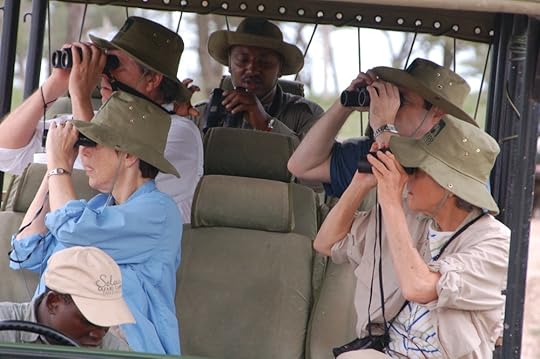
2. LUGGAGE RESTRICTIONS
Your pre-trip safari packet will tell you that the small bush planes in Africa have weight restrictions. Take the weight restrictions seriously. It’s not like on a normal flight where you pay a fee if your luggage is overweight. On these small planes the pilot has the right – and I have seen them do it – to leave overweight luggage behind. Don’t let it be yours.
3. PACKING
Because of the weight restrictions, packing requires some thought. The best clothes to bring are light-weight-material hiking (safari) clothes. Not because you will look the part of the khaki clad safari tourist, but because they weigh the least and are fast drying. Laundry in the bush is hand washed and hung to dry.
More Details on my YouTube channel, Lori Saving Wild.
4. SHOTS
Many doctors will tell you to get a variety of shots before your safari to Africa. The decision on what shots to get is up to you (and your doctor) but with a little research (and information from your operator) you will learn that there are many destinations where no shots at all are required.
Shot requirements depend on where you are travelling to and from. For instance if you are arriving in Kenya from the United States you do not need any shots. In the recent past, Tanzania was requiring yellow fever shots (but not checking to make sure the travelers had gotten them) and now they don’t require them. This can and does change so get the latest information directly from your tour operator.
5. FOOD
People I talk to always have concern about the food. I don’t blame them. Memories from experiences with montezumas revenge are not easily forgotten. Meals, like other parts of a safari, change drastically by price point. There is a lot of fresh fruit, and vegetables and local meat. But the way these perishables are stored, washed (or not), cooked and presented can be vastly different. The best (more expensive) hotels, lodges and camps wash all their food with filtered water before serving it, have great chefs and prepare some of the best meals I have ever had. In the case of having safe food the higher end safaris are your best bet.
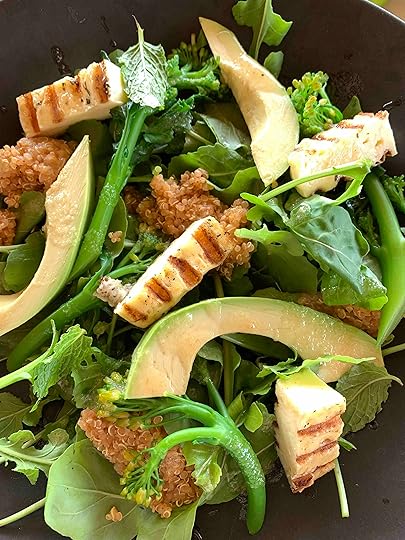 Lunch with fresh greens from the garden at one of my favorite safari camps.
Lunch with fresh greens from the garden at one of my favorite safari camps.6. WATER
Do not drink the water, or brush your teeth with it. The best safari operators provide bottled water throughout your trip.
I hope you found my top tips for a better African safari useful. Let me know in the comments below what other questions you have.
The post Top Tips for a Better African Safari appeared first on Saving Wild.
May 29, 2020
Helping Africa Survive COVID 19
COVID 19’s effect on the world is unprecedented. Every industry is experiencing its impact. As a safari planning specialist for the past 2 decades, I have intimate insight into the devastation caused by Covid 19 on the African safari business in particular.
On my beach walk this morning I stopped to chat with a philanthropist friend who shares my passion for Africa. “There is a massive need there right now, and I don’t know how to help,” she said.
I told her what I am going to tell you.
What I think is the most effective way to help Africa’s people, its wild places, and its animals. How to best protect rhino and elephant from poachers, to convert areas from hunting with guns to hunting with cameras, and support the local communities that are protecting those animals.
To truly have an impact.
The best remedy is to go on an African safari.
Why?
Because the money you pay for your African safari trickles down. It goes from the lodge to the staff who cook, clean, and care for your every need, to the driver/guide- your teacher and protector in the bush, to the local man selling produce to the lodge for your lunch, to the anti-poaching rangers protecting rhino, elephant, pangolin, and lions. In many areas, your money also pays a lease fee to the local community, like the Masai in Kenya’s Masai Mara Reserve. Those funds then help support every man, woman, and child in that area. That support in turn acts as an incentive to those same local people to protect the wild places and wild beings that tourists pay to experience. It comes full circle.
It’s a win-win for everyone involved.
Of course, this trickle-down effect works in the opposite direction as well. Africa is experiencing that right now from COVID 19. Every safari trip I’ve booked for clients in 2020 have been or will be, rescheduled for 2021. That means there is no safari money circulating through that complex, wonderfully supportive system this year, except for deposits the clients had paid pre-COVID 19.
The good news is that most people are postponing their safari plans, and not outright canceling them. Deposits from those trips, as well as money from new bookings, are providing much-needed confidence and funds to the safari industry during this critical time. It enables African safari operators and lodges to keep local people employed and conservation projects afloat while waiting for things to return to ‘normal’.
A Surprising Way Safaris Helps protect Wildlife
Tourists roaming around the Parks looking at wildlife is a great deterrent to poachers. COVID 19 restrictions are leaving Parks empty and more vulnerable. One bit of good news though from COVID as it relates to poaching is that travel bans are preventing the products – horn, tusk, skin, etc. – from export.
Going on a safari is also a great choice if you want a vacation but are now squeamish about booking a cruise, sightseeing in places with huge crowds, or standing in long lines at museums and entertainment parks. An African safari has always been a place for people wanting space, privacy, and remoteness. Now more than ever, it’s an ideal choice for a special destination.
I would love to help you figure out the perfect itinerary for your safari. If you want to go to Africa within the next year or two don’t delay in starting to make your safari arrangements. My favorite camps are almost completely booked for 2021 because of adding all of the 2020 guests to the booking schedules. It’s not too early to make your bookings for 2022. Contact me to get the conversation started.
The post Helping Africa Survive COVID 19 appeared first on Saving Wild.
January 31, 2020
How Touching Whales Helped Me Get A Divorce
When one of the largest animals in the world surfaces within two feet of my kyak, and people scream from the upper deck of a nearby Santa Barbara, California whale- watching boat, “Watch out, you’re going to be capsized,” a normal reaction would be to paddle away from there as fast as humanly possible.
Instead, I rest my oar on my lap and smile widely to the well-meaning crowd. I don’t want to miss this close encounter with a whale.
If this were a month earlier I wouldn’t have been this relaxed. But I’ve just returned from three days surrounded by gray whales in Mexico, and I’m now confident the 40-ton animal swimming next to me has no interest in capsizing my tiny kyak.
“Other animals sometimes seem to recognize in us a kind of kindred consciousness that we often fail to recognize in them.” From the book Beyond Words by Carl Safina.
~~~~~~~~~~~~~~~~~
I want to touch a whale. That had been on my bucket list for as long as I can remember.
When I finally realized that wish I was feeling stuck and unhappy in a marriage that wasn’t working for either of us.
Being in Nature is always my antidote for big life issues. And my marital situation qualified.
So I took a trip to meet whales in Mexico.
On my first night there, tucked in a canvas tent, on the moon-scape sandy edge of San Ignacio lagoon, I lay awake for hours excitedly listening to hundreds of whales breaching and slapping the water with their flukes. What are they saying to each other? What are they saying to me?
In the morning our panga driver motors five tourists, me, and Chris, our naturalist guide, around the lagoon hoping for an ‘encounter.’
Every year gray whales migrate south from their feeding areas in the frigid waters of the Bering and Chukchi Seas, to mate and give birth in the relatively calm warm water ‘nursery’ of Magdalena Bay in Baja California and this place, San Ignacio lagoon in Mexico. Their 10,000-mile round-trip journey is the longest migration of any mammal.
Salty spray sprinkles our faces as we bounce over the waves. “There,” Chris points to a ‘footprint’, a smooth oval shape created when whales propel themselves deeper underwater. Our driver idles the engine, an invitation that we are available for a visit if and when the whales are ready.
We lean over the side of the boat to slap the surface of the water. “It calls the whales in,” Chris tells us. “They are very curious beings.” As I slap, I’m silently begging the whales: Pick our boat. We’re friendly. We love you.
Within minutes an animal the length of our skiff appears just below the surface a few feet away.
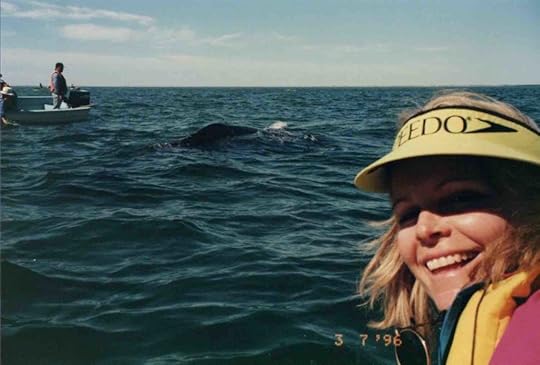 Our first close encounter is about to happen.
Our first close encounter is about to happen.It’s a baby.
I stretch out over the side of the boat, reaching, reaching, reaching. Then mom swims under and lifts her baby so the top curve of its spine is out of the water and I make skin to skin contact. Slowly I glide my hand across the rubbery soft dark gray skin, trying to avoid the mottled white patches of sharply edged barnacles that have taken up permanent residence.
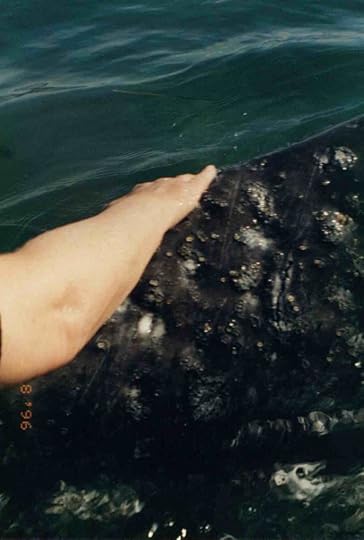 Contact.
Contact.Time stands still.
Then the baby swims out of the way as the 40-foot long mother maneuvers sideways until I am looking straight into her left eye. As I write this I can feel the tears wanting to flow again. I remember ‘knowing’ something I did not then ‘understand.’ This female whale is initiating contact with us humans. Every cell in my body can feel her connecting to me.
In her presence, I sense a vast pool of peacefulness, understanding and wisdom. She knows things I can never know – about the planet – about the earth, about her water world, and about me.
I feel completely present and ‘in the moment’ and as if I am enveloped by the purest love I have ever known.
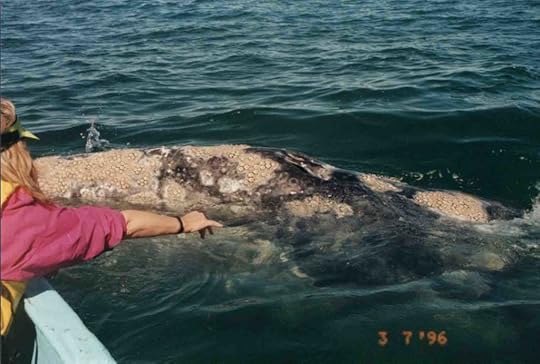 I wanted to touch every whale we saw, and there were hundreds.
I wanted to touch every whale we saw, and there were hundreds.For the next three days, each time I ‘meet’ a whale I feel as if I’m being blessed by an ancient soul. As if I am in a loving mothers womb, protected and supported. Each encounter leaves me clearer and stronger.
When I return home to Santa Barbara it is those whales that continue, during the following year, to give me the courage and fortitude needed to finalize my divorce.
~~~~~~~~~~~~~~~~~~~~~~~~~~~~~
If touching whales is on your bucket list, January through April are the best months to go. There are many tour operators you can use, or you can plan it on your own. San Ignacio Lagoon and Magdalena Bay are the top two spots for touching whales. But be warned, touching whales may drastically change your life.
LvL
*Photos by Chris Peterson
The post How Touching Whales Helped Me Get A Divorce appeared first on Saving Wild.
November 17, 2019
Instead of the Kruger National Park, go here…
The Kruger National Park is to South Africa what the Masai Mara is to Kenya. It’s this countries most popular wildlife safari destination.
But Kruger is crowded, with paved roads that feel like you are on a highway rather than in the wild. And a safari in Kruger can feel more like you are on a tour rather than really connecting to the land and the animals.
To solve that problem, I have some advice.
Rather than staying directly in Kruger, consider staying in areas outside the Park, in what’s called the Greater Kruger National Park (GKNP). This area consists of over 20 private reserves of 180,000 hectares of unfenced land on the West side of the Kruger National Park. The wildlife moves freely through this total area of 20,000,000 hectares (49,400,000 acres) and the reserves offer benefits you don’t find inside Kruger National Park.
Staying in one of the private reserves will cost you more money. But what you get in return is worth it.
You will have a more wild experience. You will have fewer vehicles at a sighting, and sometimes maybe yours will be the only truck at a sighting. You will have exclusivity – no self drivers are allowed in this area. And you will get the wisdom from some of South Africa’s top guides and trackers.
Probably the best known of the private reserves is Sabi Sands.
Sabi Sands is known as the area for honeymooners. Many of the lodges have special package deals for the newlyweds which include Cape Town, and a 3 or 4-night safari, before heading off to an exotic island. In fact, at every lodge I visited in this private reserve I met at least one couple on their honeymoon.
The area is also known for leopard sightings. The lodges in Sabi Sands have worked hard to habituate these big cats to trucks and tourists. Spending limited amounts of time with newborn cubs, then slowing increasing exposure until the cats are so comfortable, they will eventually walk nonchalantly within inches of the trucks full of tourists. Considering how shy and elusive these cats are in other areas of Africa, to be this close to leopards is a special privilege. So, if leopards are your thing, then Sabi Sands is your place.
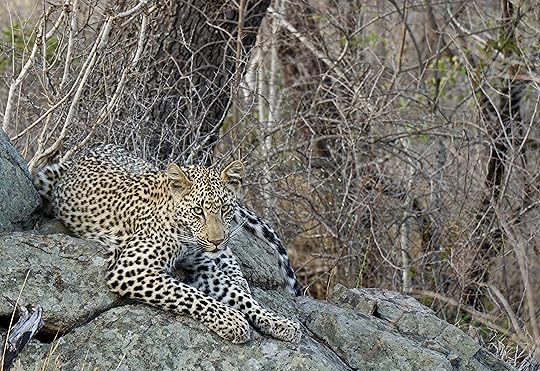
Accommodation in the GKNP is more exclusive, with smaller camps, great service, and more luxurious amenities. I spent almost 2 weeks visiting 11 lodges in Sabi Sands recently and want to share my favorites with you.
Here are my top choices for your Greater Kruger National Park area lodges:
Boulders. The décor is inspired by the five elements – earth, wind, fire, air, and water -and the place has a sexy, modern, upbeat vibe. They have a workout gym, and spa, excellent management, staff, trackers, and guides. Monkeys are climbing on the rafters in the lounge, “it’s their place as much as it is ours,” is the attitude here. Boulders is one of my all-time favorite lodges I have ever stayed at. To see why, watch my video of Boulders Lodge, here.
Dulini River Lodge. The Dulini Collection has three lodges and also a connection to Savanna Lodge. I loved them all. But the beauty of the River Lodge is it’s light, sunny and airy aesthetic. It is simply exquisite. Take a video tour of their main lodge here to get a feel for what I’m talking about. Set among towering trees alongside a river, leopards are often seen around the camp. The staff has to put the cushions from the outdoor furniture away at night because the leopards have been known to chew them to bits.

Londolozi Varty Camp. A great choice if you are looking for a family safari or a safari/vaca combo. There is a state-of-the-art wellness center on-site with a Himalayan salt cave/freeze pool treatment that took away all the aches and pains I had from bouncing around in safari trucks for 2 months. They hold daily yoga classes before lunch and offer retreats in the bush with some re-known life coaches. They are known for having world-class trackers. And, the food is of superb quality with greens from their own garden.
 Lunch with fresh greens from the garden.
Lunch with fresh greens from the garden.
Let me help create a life-changing South Africa safari adventure for you that will be much better than going to the Kruger National Park.
The post Instead of the Kruger National Park, go here… appeared first on .



